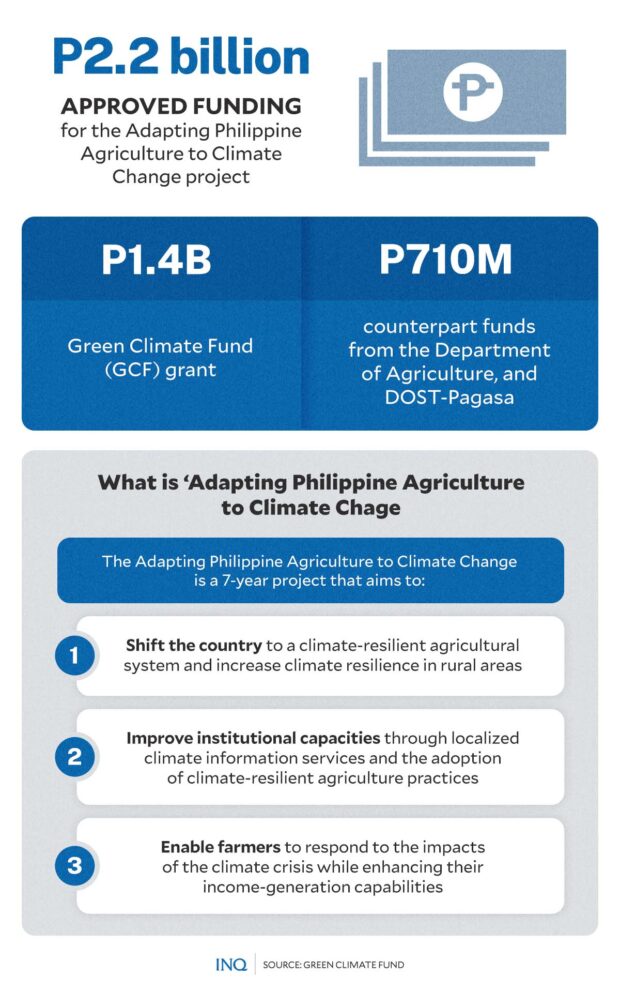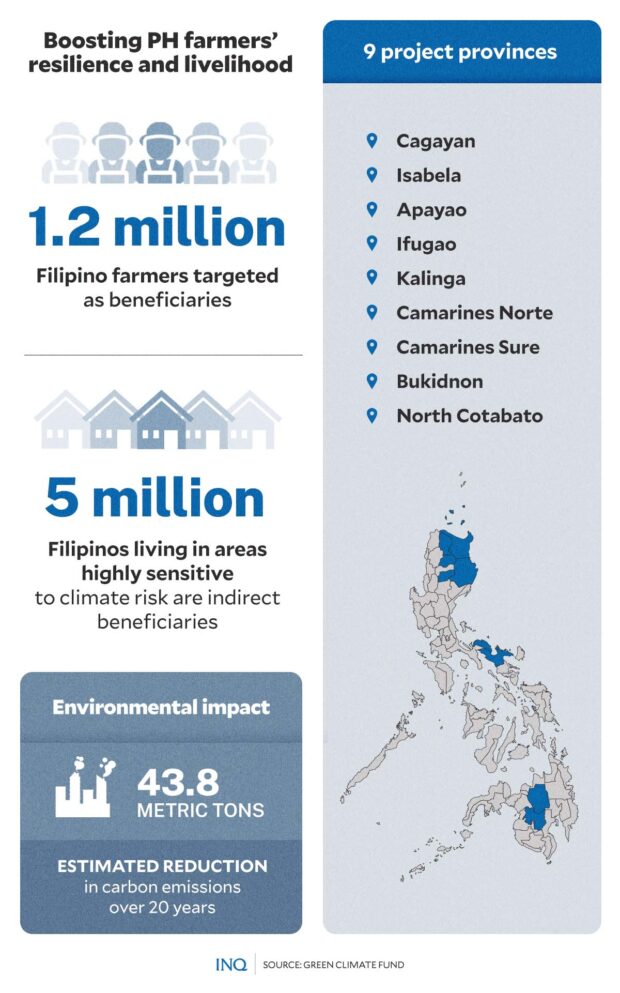 COMPOSITE IMAGE: Daniella MARIE AGACER FROM INQ STOCK PHOTOS
COMPOSITE IMAGE: Daniella MARIE AGACER FROM INQ STOCK PHOTOS
MANILA, Philippines—The Philippines—named the most disaster-prone country in the world—has been recently granted a P2.2 billion investment to help adapt agricultural systems to climate change.
The World Risk Risk Report 2022 ranked the Philippines as the most disaster-prone among 193 countries, with a very high vulnerability score of 54.81. This is based on the susceptibility of populations to damage from extreme natural disasters events or the negative impacts of climate change.
In the Philippines, which is expected to experience increasingly more frequent and catastrophic extreme weather events, nearly 10 million people work in the agriculture sector.
Previous studies revealed that the impact of climate change on Philippine agriculture is devastating. The country incurred P290B in agricultural damages in the past decade due to extreme weather events.
To help the government “shift the country towards a climate-resilient agricultural system and increase climate resilience in rural areas,” the Green Climate Fund (GCF) has approved a $39.2M (₱2.2B) funding proposal for an initiative called Adapting Philippine Agriculture to Climate Change.
Boosting farmers’ climate resilience
The 7-year initiative will be supported by a $26.2M (₱1.4B) GCF grant and $12.9M (₱710M) in co-financing from the Department of Agriculture (DA), and the Philippine Atmospheric, Geophysical, and Astronomical Services Administration (PAGASA) to boost the resilience of climate-vulnerable rural smallholder farmers.
“The initiative will directly benefit 1.25 million rural men and women Filipino farmers by raising their awareness of climate risks and risk-reduction measures, building their capacity to develop enterprises and to access finance and related technologies, and adopting climate-resilient agriculture (CRA) practices,” the Food and Agriculture Organization of the United Nations (FAO) explained.
According to FAO, innovative CRA practices offer options to help the country respond to the challenges of a changing climate.

GRAPHIC Ed Lustan
“Crop- and system-specific practices, incorporating indigenous food production systems, present viable solutions that increase climate-resilience of and improve food security,” the UN organization said.
“Investments in more integrated farm systems can also reduce farmers’ vulnerability to the climate crisis and incentivize the uptake of CRA,” it added.
The project will help the most vulnerable communities by strengthening the capacities of the government and the private sectors to develop and provide climate information (CIS) effectively.
Aside from aiding rural Filipino farmers to respond to the impacts of the climate crisis, the project also aims to enhance their income-generation capabilities and livelihoods.
It is expected to improve the natural resources and agricultural land that farmers work on based on improved CRA practices and natural resources management, including water management.
More beneficiaries, environmental impact
Aside from supporting the most vulnerable farmers, over 5 million people living in the area that are highly sensitive to climate risk in nine provinces will also benefit indirectly from the collaborative initiative.
The target provinces include Cagayan, Isabela, Apayao, Ifugao, Kalinga, Camarines Norte, Camarines Sure, Bukidnon, and North Cotabato—which experience either increasing or decreasing precipitation, intensified cyclones, and rising temperatures due to climate change.

GRAPHIC Ed Lustan
The project will also focus on women and marginalized indigenous communities’ participation in the widespread adoption of CRA in the country—and that they benefit from it—by providing them access to targeted climate information and technical services for CRA.
“This will be achieved through the complementary bundling of agriculture practices with value chain linkages, appropriate finance and risk transfer, and where possible, the use of innovative emerging mobile technologies,” FAO stated.
“Socially speaking, livelihoods are expected to improve based on increased adaptive capacities within the target communities. This is also expected in the instances of IP groups, with expected impacts of increased resiliency and adaptive capacities which are sensitive to the traditional and cultural preferences of those communities,” it added.
The initiative will also cut 4.38 metric tons of carbon emissions over 20 years through better land use and climate-friendly agriculture practices.
